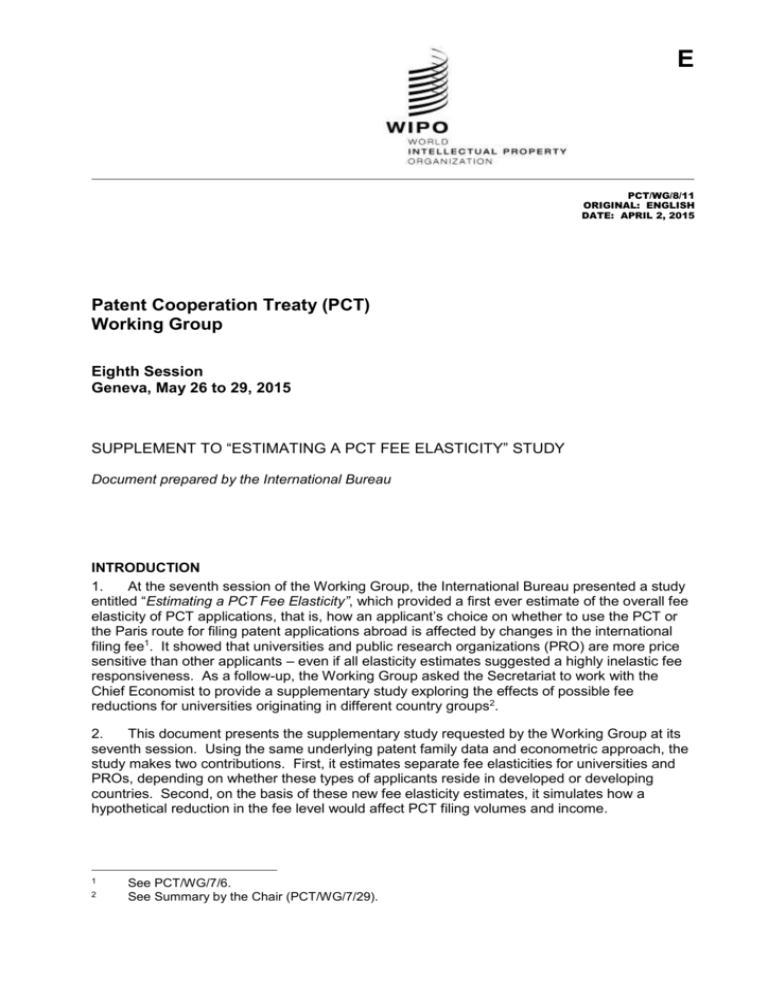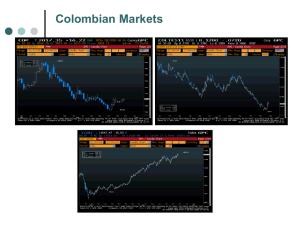Supplement to “Estimating a PCT Fee Elasticity”
advertisement

E PCT/WG/8/11 ORIGINAL: ENGLISH DATE: APRIL 2, 2015 Patent Cooperation Treaty (PCT) Working Group Eighth Session Geneva, May 26 to 29, 2015 SUPPLEMENT TO “ESTIMATING A PCT FEE ELASTICITY” STUDY Document prepared by the International Bureau INTRODUCTION 1. At the seventh session of the Working Group, the International Bureau presented a study entitled “Estimating a PCT Fee Elasticity”, which provided a first ever estimate of the overall fee elasticity of PCT applications, that is, how an applicant’s choice on whether to use the PCT or the Paris route for filing patent applications abroad is affected by changes in the international filing fee1. It showed that universities and public research organizations (PRO) are more price sensitive than other applicants – even if all elasticity estimates suggested a highly inelastic fee responsiveness. As a follow-up, the Working Group asked the Secretariat to work with the Chief Economist to provide a supplementary study exploring the effects of possible fee reductions for universities originating in different country groups2. 2. This document presents the supplementary study requested by the Working Group at its seventh session. Using the same underlying patent family data and econometric approach, the study makes two contributions. First, it estimates separate fee elasticities for universities and PROs, depending on whether these types of applicants reside in developed or developing countries. Second, on the basis of these new fee elasticity estimates, it simulates how a hypothetical reduction in the fee level would affect PCT filing volumes and income. 1 2 See PCT/WG/7/6. See Summary by the Chair (PCT/WG/7/29). PCT/WG/8/11 page 2 NEW ELASTICITY ESTIMATES 3. Relying on the same data and adopting the same econometric approach outlined in document PCT/WG/7/6 – henceforth referred to as “the earlier study” – one can estimate origin-specific fee elasticities for different applicant entities by interacting the fee variable with dummy variables for universities and PROs, as well as with dummy variables indicating developing and developed country origin.3 Table 1 provides two different estimates implementing this approach. The first one – presented in column (1) – includes all the variables employed in the earlier study, except the unemployment rate. Exclusion of the unemployment rate leads to a larger estimation sample that includes more developing countries. The estimation results are comparable to the ones of the earlier study, except that the coefficients on the size dummy variables are not statistically significant. The interacted fee variables confirm that university and PRO applicants are more fee sensitive than other applicants. In addition, they show that universities from developing countries are more fee sensitive than universities from developed countries, whereas the coefficient estimates for PRO applicants are quite similar. All fee coefficients are statistically significant. Table 1: Probit estimation results 𝐥𝐧𝒇𝒊𝒋𝒕 * (University applicant) * (Developed country) 𝐥𝐧𝒇𝒊𝒋𝒕 * (University applicant) * (Developing country) 𝐥𝐧𝒇𝒊𝒋𝒕 * (PRO applicant) * (Developed country) 𝐥𝐧𝒇𝒊𝒋𝒕 * (PRO applicant) * (Developing country) 𝐥𝐧𝒇𝒊𝒋𝒕 * (Other applicants) (1) -0.157*** (-7.86) -0.330*** (-14.12) -0.130*** (-6.55) -0.114*** (-3.58) -0.074*** (-3.79) 𝐥𝐧𝒖𝒏𝒆𝒎𝒑𝒋𝒕 University applicant PRO applicant 2 offices 3 offices 4 offices 5 offices 6 or more offices 𝒎𝒌𝒕𝒋(𝒕−𝟏𝟐) 1.309*** (50.86) 0.680*** (29.99) -0.596 (-1.08) -0.244 (-0.44) 0.066 (0.12) 0.289 (0.52) 0.595 (1.07) 0.767*** (14.72) (2) -0.118*** (-5.66) -0.346*** (-13.27) -0.085*** (-4.12) 0.066 (1.09) -0.035* (-1.73) -0.106*** (-12.86) 1.306*** (49.78) 0.619*** (26.74) -0.700*** (-4.49) -0.336** (-2.16) -0.022 (-0.15) 0.200 (1.28) 0.505*** (3.23) 0.768*** (14.40) Developing countries are defined as the ones listed in Official Notices (PCT Gazette) – 12 February 2015; all other countries are defined as developed countries. 3 PCT/WG/8/11 page 3 Technology field fixed effects Origin fixed effects Time fixed effects Observations Log-likelihood (1) Yes Yes Yes 1,153,970 -600,361.95 (2) Yes Yes Yes 1,128,006 -586,451.81 Note: z-statistic in parentheses; ***,**, and * indicate statistical significance at 1, 5, and 10 per cent, respectively. 4. Column (2) presents the estimation results when including the unemployment rate. The results change in three respects. First, several of the size dummy variables are now statistically significant – in line with expectations and with the results obtained in the earlier study. Second, except the fee coefficient for university applicants from developing countries, the estimated fee coefficients are smaller in size. Third, the fee coefficient for PROs from developing countries is not any more statistically significant and even takes on a positive sign. However, this is due to the smaller estimation sample, which only relies on 78 PRO patent families originating in developing countries, of which 90 per cent had a PCT equivalent. 5. Overall, the estimation results in column (2) are bound to be more reliable. Given the strong correlation between the fee level and the business cycle through the exchange rate – as explained in the earlier study – it is important to control for the unemployment rate in the estimation. The analysis that follows will therefore rely on these estimation results. However, it will not further consider the filing behavior of PROs from developing countries separately. This is partly because the results in column (1) suggest a similar fee responsiveness as the one observed for developed country PROs and partly because of doubts of having correctly identified PROs in the dataset.4 6. Table 2 presents the marginal effects associated with the probit coefficient estimates obtained in column (2) of Table 1.5 One can interpret these marginal effects as percentage probabilities of opting for the PCT or, alternatively, as changes in the PCT market share resulting from changes in the explanatory variables. Dividing the marginal effect estimates on the fee variables by actual PCT market shares for different applicant groups then yields elasticity estimates with respect to PCT filing volume – as shown in Table 3.6 The results suggest that the fee elasticity for university applicants from developing countries is four times as large as the one for university applicants from developed countries – which, in turn, is twice as large as the fee elasticity for other applicants. Interestingly, the PCT market share for universities from developing countries is substantially lower than that for universities from developed countries – pointing to unrealized potential for developing country universities to use the PCT system. 4 As explained in the earlier study, the identification of university and PRO applicants relies on a keyword-based search algorithm, which is bound to be more reliable for universities than for PROs. 5 6 These marginal effects were computed using the “margins, dydx(variable)” command in STATA. The elasticity estimates presented in Table 3 rely on the actual PCT market shares in the estimation sample, rather than the full sample unconstrained by data availability on other variables in the econometric model. In the case of university applicants from developing countries, the number of observations in the estimation sample is less than a fifth of than in the full sample. However, the market shares in the two samples are similar. In addition, the coefficient estimate on the fee variable for developing country universities proved robust to different estimation samples – not only the one presented in column (1) of Table 1, but also a specification that relied on nominal instead of real fees for which the estimation sample was closer to the full sample shown in Table 3. PCT/WG/8/11 page 4 Table 2: Marginal effects associated with probit estimates 𝐥𝐧𝒇𝒊𝒋𝒕 * (University applicant) * (Developed country) -0.035*** 𝐥𝐧𝒇𝒊𝒋𝒕 * (University applicant) * (Developing country) -0.102*** 𝐥𝐧𝒇𝒊𝒋𝒕 * (Other applicants) -0.010* 𝐥𝐧𝒖𝒏𝒆𝒎𝒑𝒋𝒕 -0.312*** University applicant 0.384*** PRO applicant 0.182*** 2 offices -0.206* 3 offices -0.099** 4 offices -0.007 5 offices 0.059 6 or more offices 0.148*** Note: the marginal effects shown relate to the coefficient estimates of the corresponding variables in column (2) in Table 1; the marginal effects for other variables are suppressed here. Table 3: Market shares and elasticity estimates Full sample #obs PCT share University (developed 24,754 0.865 country) University (developing 3,609 0.675 country) Other applicants 1,342,593 0.492 Estimation sample #obs PCT share 20,730 0.861 Implied elasticity -0.040 453 0.620 -0.164 1,092,352 0.489 -0.021 Note: the elasticity estimates rely on the actual PCT market shares in the estimation sample. SIMULATION OF VOLUME AND INCOME EFFECTS 7. One can use the elasticity estimates presented in Table 3 to simulate how hypothetical fee reductions would affect filing volumes and income. Tables 4 and 5 present such simulation exercises for universities from developing and developed countries, respectively. The first segment of each table presents actual filing and income figures from 2008 to 2014, along with the implied average fee. The other segments then calculate the number of additional filings, the average fee payment, and the income effect – both in absolute terms and relative to total PCT income – for hypothetical fee reductions of 10, 25, and 50 per cent. 8. The econometric model imposes a log-linear functional form on the impact of the PCT fee. In other words, it assumes that a 20 per cent fee change will have double the effect of a 10 per cent fee change, and half the effect of a 40 per cent fee change. This assumption may be especially questionable for large fee changes that exceed historical experience. (For this reason, Tables 4 and 5 do not present simulation results for hypothetical fee changes exceeding 50 per cent). In particular, a fee reduction of 90 per cent –corresponding to the reduction currently offered to applicants from least-developed countries and natural persons from certain other countries – is not included. PCT/WG/8/11 page 5 Table 4: Hypothetical fee reductions for universities from developing countries Actual performance Number of PCT Income from those Implied average fee filings filings (in CHF) (in CHF millions) 2008 552 0.771 1,396.74 2009 674 0.918 1,362.02 2010 1,024 1.296 1,265.63 2011 1,336 1.609 1,204.34 2012 1,282 1.693 1,320.59 2013 1,460 1.806 1,236.99 2014 1,694 2.305 1,360.68 10 per cent fee reduction 2008 2009 2010 2011 2012 2013 2014 Number of additional filings 9 11 17 22 21 24 28 Average fee (in CHF) 1,257.07 1,225.82 1,139.06 1,083.91 1,118.53 1,113.29 1,224.62 Income effect (in CHF millions) -0.066 -0.078 -0.110 -0.137 -0.144 -0.154 -0.196 Income effect (as % of total PCT income) -0.03 -0.04 -0.05 -0.06 -0.06 -0.06 -0.07 Income effect (in CHF millions) -0.169 -0.201 -0.284 -0.353 -0.371 -0.396 -0.505 Income effect (as % of total PCT income) -0.07 -0.10 -0.14 -0.16 -0.14 -0.16 -0.17 Income effect (in CHF millions) -0.354 -0.421 -0.595 -0.739 -0.777 -0.829 -1.058 Income effect (as % of total PCT income) -0.16 -0.20 -0.29 -0.34 -0.30 -0.33 -0.36 25 per cent fee reduction 2008 2009 2010 2011 2012 2013 2014 Number of additional filings 23 28 42 55 53 60 69 Average fee (in CHF) 1,047.55 1,021.51 949.22 903.26 990.44 927.74 1,020.51 50 per cent fee reduction 2008 2009 2010 2011 2012 2013 2014 Number of additional filings 45 55 84 110 105 120 139 Average fee (in CHF) 698.37 681.01 632.81 602.17 660.30 618.49 680.34 Note: the number of additional filings relies on the fee elasticity estimate presented in Table 3; the average fee in the simulation scenario applies the hypothetical fee reduction to the actual average fee presented in the first table segment. PCT/WG/8/11 page 6 Table 5: Hypothetical fee reductions for universities from developed countries Actual performance Number of PCT Income from those Implied average fee filings filings (in CHF) (in CHF millions) 2008 8,740 12.209 1,396.91 2009 8,965 12.204 1,361.29 2010 9,186 11.630 1,266.06 2011 9,786 11.789 1,204.68 2012 10,517 13.887 1,320.43 2013 10,437 12.910 1,236.95 2014 10,638 14.474 1,360.59 10 per cent fee reduction 2008 2009 2010 2011 2012 2013 2014 Number of additional filings 35 36 37 39 42 42 43 Average fee (in CHF) 1,257.22 1,225.16 1,139.45 1,084.21 1,188.39 1,113.25 1,224.53 Income effect (in CHF millions) -1.177 -1.176 -1.121 -1.136 -1.339 -1.245 -1.395 Income effect (as % of total PCT income) -0.52 -0.56 -0.54 -0.52 -0.52 -0.49 -0.48 Income effect (in CHF millions) -2.961 -2.959 -2.820 -2.859 -3.368 -3.131 -3.510 Income effect (as % of total PCT income) -1.30 -1.40 -1.36 -1.30 -1.31 -1.23 -1.20 Income effect (in CHF millions) -5.982 -5.980 -5.699 -5.777 -6.805 -6.326 -7.092 Income effect (as % of total PCT income) -2.62 -2.83 -2.74 -2.63 -2.64 -2.49 -2.43 25 per cent fee reduction 2008 2009 2010 2011 2012 2013 2014 Number of additional filings 87 90 92 98 105 104 106 Average fee (in CHF) 1,047.68 1,020.97 949.54 903.51 990.33 927.71 1,020.45 50 per cent fee reduction 2008 2009 2010 2011 2012 2013 2014 Number of additional filings 175 179 184 196 210 209 213 Average fee (in CHF) 698.46 680.65 633.03 602.34 660.22 618.47 680.30 Note: the number of additional filings relies on the fee elasticity estimate presented in Table 3; the average fee in the simulation scenario applies the hypothetical fee reduction to the actual average fee presented in the first table segment. PCT/WG/8/11 page 7 9. Reflecting the higher value of the elasticity estimate, PCT filings from universities in developing countries are more responsive to fee reductions in relative terms. However, due to substantially higher actual filing volumes, the absolute number of additional filings induced by any given fee discount is higher for universities from developed countries. For the same reason, the income effect of any given fee reduction is substantially larger for universities from developed countries. 10. Reflecting the elasticity estimates and actual filing volumes, fee reductions for universities from developing countries are more “cost effective” at generating additional filings. For example, in 2014, a fee reduction of 25 per cent for developing country universities would have induced 69 additional filings, at an “income loss” of 0.5 million Swiss francs, whereas a 10 per cent fee reduction for developed country universities would have induced only 43 additional filings, at an “income loss” of 1.4 million Swiss francs. CONCLUSION 11. This supplementary study has provided separate fee elasticities for universities and PROs from developing and developed countries. In the end, only the elasticity estimate for universities turned out to be meaningfully different depending on the origin of applicants. On the basis of the fee elasticities estimated, the study then simulated how hypothetical fee reductions would affect PCT filing volumes and income. 12. All fee elasticity estimates continue to suggest a highly inelastic response of applicants to fee changes. Accordingly, the additional filing volume generated by hypothetical fee reductions remains relatively small. However, a fee reduction for universities from developed countries would have a noticeable effect on income – reflecting the losses which would be incurred due to the fee reductions being applied to the high existing filing volumes from these entities. 13. While the elasticity estimates are statistically significant, robust to different specifications of the econometric model, and accord with intuition, they should still be treated with caution, for at least two reasons. First, the underlying econometric model captures the choice applicants face between the Paris route and the PCT routes towards international patent filing. It ignores that the level of the PCT fee might affect applicants’ decision on whether to file for patent protection internationally to begin with. If the fee mattered for this decision, the elasticity estimates presented here would underestimate the likely filing response. Second, as noted in paragraph 8, above, the assumptions used in the model become questionable for estimating the number of additional filings, and the effect on revenue, for large fee changes that exceed historical experience. 14. The Working Group is invited to take note of the contents of the present document. [End of document]






